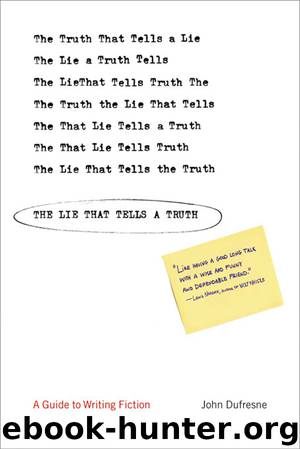The Lie That Tells a Truth by John Dufresne

Author:John Dufresne
Language: eng
Format: epub
Publisher: W. W. Norton & Company
Published: 2011-11-21T16:00:00+00:00
Plottery
Life is very nice, but it lacks form. It’s the aim of art to give it some.
—Jean Anouilh
An idea is not a story. A first draft is not a story. A moral is not a story. A character is not a story. A theme is not a story. A plot—now, that’s a story! So where do I get me one? you might ask. At your writing desk. Because plots don’t exist. They can’t be shopped for or ordered on-line. They are coaxed into being. They develop. They grow in the course of the writing. A plot begins to form as soon as you begin to ask yourself the appropriate narrative questions: What does my central character want? What is preventing her from getting it? What does she do about the various obstacles in her way? What are the results of what she does? What climax does this all lead to? Does she get what she wants in the end? Plot, then, is the element of fiction that shapes the many other elements—character, theme, point of view, language, and so on—into a story. It’s the organizing principle of narration, let’s say. It’s the what happens, the action. The critic R. S. Crane explained plot as “a completed process of change.” Joyce Carol Oates called plot “the aesthetic approximation of gravity.” Plot is the force that holds the universe of your story together.
When constructing your plots, don’t be satisfied with a situation in which you can already see or sense a resolution of the struggle. In other words, don’t conceive a plot with ease of execution in mind. The plot is not about you, but about the characters. And it’s not about ease; it’s about obstruction. You ought to think of situations which seem unresolvable. A young couple at a Delaware motel toss their newborn baby into a Dumpster.
Aristotle, our first drama critic, defined plot, in 355 BCE or so, as the structuring of the events of the story. He considered plot more important than character. Indeed, he wrote that “a tragedy cannot exist without a plot, but it can without characters.” But, honestly, can you think of a characterless drama that you’d watch or read? I can’t. And as the questions proposed in the first paragraph suggest, you cannot separate plot from character. Think of plot as the solution to the central character’s problem. Plot is what the character does to get what she wants. Perhaps, then, Aristotle was overstating his case. And he would certainly disapprove of what some modern writers have had to say about the primacy of plot:
“I don’t work with plots. I work with intuition, apprehension, dreams, concepts. . . . Plot implies narrative and a lot of crap. It is a calculated attempt to hold a reader’s interest at the sacrifice of moral conviction.” So spoke John Cheever. Not that he didn’t develop plots, mind you, just that he didn’t “work” with them. Nelson Algren said he just kept writing until his story found its own plot.
Download
This site does not store any files on its server. We only index and link to content provided by other sites. Please contact the content providers to delete copyright contents if any and email us, we'll remove relevant links or contents immediately.
Asking the Right Questions: A Guide to Critical Thinking by M. Neil Browne & Stuart M. Keeley(5712)
Autoboyography by Christina Lauren(5206)
Eat That Frog! by Brian Tracy(4484)
Dialogue by Robert McKee(4354)
Sticky Fingers by Joe Hagan(4148)
Journeys Out of the Body by Robert Monroe(3590)
Annapurna by Maurice Herzog(3449)
Full Circle by Michael Palin(3417)
Schaum's Quick Guide to Writing Great Short Stories by Margaret Lucke(3348)
Elements of Style 2017 by Richard De A'Morelli(3325)
The Art of Dramatic Writing: Its Basis in the Creative Interpretation of Human Motives by Egri Lajos(3039)
Atlas Obscura by Joshua Foer(2934)
Why I Write by George Orwell(2916)
The Diviners by Libba Bray(2910)
In Patagonia by Bruce Chatwin(2897)
The Fight by Norman Mailer(2890)
The Mental Game of Writing: How to Overcome Obstacles, Stay Creative and Productive, and Free Your Mind for Success by James Scott Bell(2877)
Venice by Jan Morris(2548)
The Elements of Style by William Strunk and E. B. White(2454)
